HOW IS A BEE MADE?
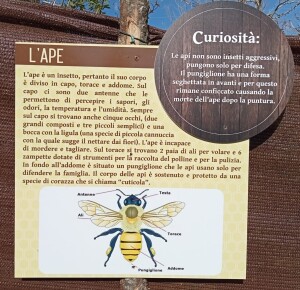 The bee is an insect and its body is divided into the head, thorax and abdomen. On the head there are two antennas that allow to perceive flavors, smells, temperature and humidity. We also find five eyes, (two large compounds and three small simple ones) and a mouth that looks like a small straw for sucking the nectar from the flowers. On the thorax there are 2 pairs of wings for flying and 6 legs equipped with tools for collecting pollen and cleaning. A sting is located at the bottom of the abdomen, but bees are not aggressive insects, they only sting for defense. The stinger has a serrated shape and for this reason it remains stuck in our skin, causing the death of the bee at the same time.
The bee is an insect and its body is divided into the head, thorax and abdomen. On the head there are two antennas that allow to perceive flavors, smells, temperature and humidity. We also find five eyes, (two large compounds and three small simple ones) and a mouth that looks like a small straw for sucking the nectar from the flowers. On the thorax there are 2 pairs of wings for flying and 6 legs equipped with tools for collecting pollen and cleaning. A sting is located at the bottom of the abdomen, but bees are not aggressive insects, they only sting for defense. The stinger has a serrated shape and for this reason it remains stuck in our skin, causing the death of the bee at the same time.
THE BIOLOGICAL CYCLE
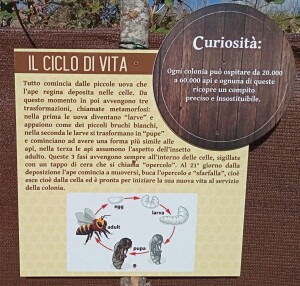 All starts with a small egg that the queen bee deposits into the cells. From this moment on, three transformations take place, called metamorphoses: in the first, the eggs become “larvae” and appear as small white caterpillars, in the second, the larvae transform into “pupae” and begin to have a shape more similar to bees, in the third the bees take on the appearance of the adult insect. All three phases always take place inside the cells, which are sealed with a wax cap. On the 21st day after deposition, the bee begins to move, pierces the cap and leaves the cell, ready to start its new life at the service of the colony. Each colony can host from 20,000 to 60,000 bees and each of these has a precise and irreplaceable task.
All starts with a small egg that the queen bee deposits into the cells. From this moment on, three transformations take place, called metamorphoses: in the first, the eggs become “larvae” and appear as small white caterpillars, in the second, the larvae transform into “pupae” and begin to have a shape more similar to bees, in the third the bees take on the appearance of the adult insect. All three phases always take place inside the cells, which are sealed with a wax cap. On the 21st day after deposition, the bee begins to move, pierces the cap and leaves the cell, ready to start its new life at the service of the colony. Each colony can host from 20,000 to 60,000 bees and each of these has a precise and irreplaceable task.
THE BEES FAMILY
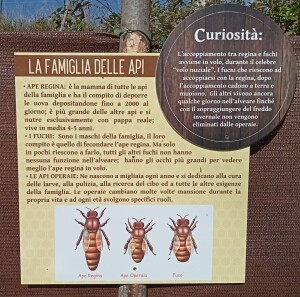 The Queen Bee: she is the mother of all the bees in the family and has the task of laying eggs, depositing up to 2.000 a day; it is larger than other bees and feeds exclusively on royal jelly; she lives on average 4-5 years.
The Queen Bee: she is the mother of all the bees in the family and has the task of laying eggs, depositing up to 2.000 a day; it is larger than other bees and feeds exclusively on royal jelly; she lives on average 4-5 years.
The Kelps: they are the males and their task is to fertilize the queen bee. Mating between queen and kelps takes place in flight, during the “nuptial flight”. Kelps that manage to mate with the queen then fall to the ground and die. The others still live a few days in the hive until with the arrival of the winter cold they are eliminated by the workers.
Worker bees: thousands of them are born every year and are dedicated to caring for the larvae, cleaning, looking for food and all the other needs of the family. Workers change jobs many times during their lives and at every age they play specific roles.
THE ROLES OF WORKER BEES
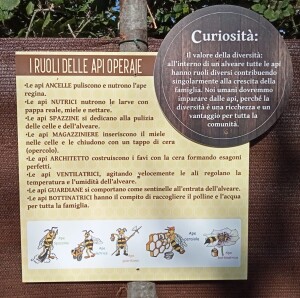 Within a beehive, all bees have different roles, contributing individually to the growth of the family. During their life the workers play various roles, there are the handmaid bees, the nurses, the sweepers, the storekeepers, the ventilators, the foragers, we even have architect bees who build the honeycombs with wax forming perfect hexagons and finally the guardians to control the entrance to the hive.
Within a beehive, all bees have different roles, contributing individually to the growth of the family. During their life the workers play various roles, there are the handmaid bees, the nurses, the sweepers, the storekeepers, the ventilators, the foragers, we even have architect bees who build the honeycombs with wax forming perfect hexagons and finally the guardians to control the entrance to the hive.
THE BEE-KEEPER
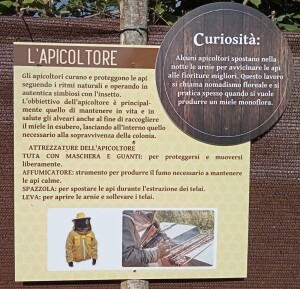 The beekeeper’s goal is mainly to keep the hives alive and healthy, also in order to collect the surplus honey, leaving inside what is necessary for the survival of the colony. Some beekeepers move the hives during the night to bring the bees closer to the best blooms. This work is called floral nomadism and is often practiced when one wants to produce honey from a single flower. Beekeepers use special tools such as the smoker, a tool to produce the smoke necessary to keep the bees calm, or the “Brush”, another tool used to move the bees during the extraction of the frames.
The beekeeper’s goal is mainly to keep the hives alive and healthy, also in order to collect the surplus honey, leaving inside what is necessary for the survival of the colony. Some beekeepers move the hives during the night to bring the bees closer to the best blooms. This work is called floral nomadism and is often practiced when one wants to produce honey from a single flower. Beekeepers use special tools such as the smoker, a tool to produce the smoke necessary to keep the bees calm, or the “Brush”, another tool used to move the bees during the extraction of the frames.
THE BEEHIVE
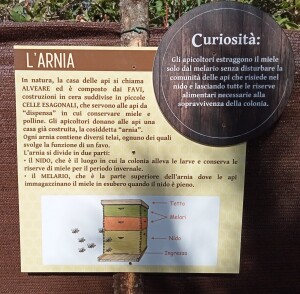 In nature, the bee house is called as beehive and is made up of wax constructions divided into small hexagonal cells. The wooden structures that are used by beekeepers are called hives and contain several frames. The hive is divided into two parts: the lower part called the “Nest” which is the place where the colony raises the larvae and keeps the honey reserves for the winter period. The upper part is the place where the bees store the excess honey when the nest is full. The beekeepers extract the honey only from this side without disturbing the nest and leaving all the food reserves necessary for the survival of the colony.
In nature, the bee house is called as beehive and is made up of wax constructions divided into small hexagonal cells. The wooden structures that are used by beekeepers are called hives and contain several frames. The hive is divided into two parts: the lower part called the “Nest” which is the place where the colony raises the larvae and keeps the honey reserves for the winter period. The upper part is the place where the bees store the excess honey when the nest is full. The beekeepers extract the honey only from this side without disturbing the nest and leaving all the food reserves necessary for the survival of the colony.
THE PRODUCTS OF BEEHIVE
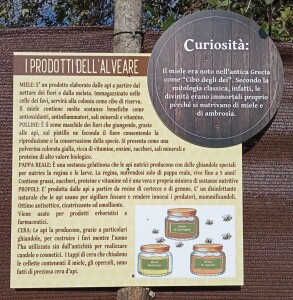 Honey: It is a product elaborated by bees starting from the nectar of flowers. It is stored in cells and will serve the colony as reserve food;
Honey: It is a product elaborated by bees starting from the nectar of flowers. It is stored in cells and will serve the colony as reserve food;
Pollen: It is the male seed of flowers which, thanks to the bees, fertilizes the flower on the pistil, allowing the reproduction and conservation of the species. It looks like a yellow colored powder, rich in vitamins, enzymes, sugars, mineral salts and proteins of high biological value;
Royal jelly: It is a gelatinous substance that the nurse bees produce with special glands to feed the queen and the larvae. The queen, feeding only on royal jelly, lives up to 5 years! It contains fats, sugars, proteins and vitamins and is a veritable mine of nutrients;
Propolis: It is produced by bees starting from bark or gem resins. It is a natural disinfectant that bees use to seal cracks and render predators harmless, mummifying them. Excellent antiseptic, healing and emollient, it is used for herbal and pharmaceutical products;
Wax: The bees produce it, thanks to particular glands, to build the honeycombs, moreover the caps that close the cells containing the honey are also made of precious beeswax.
HONEYING
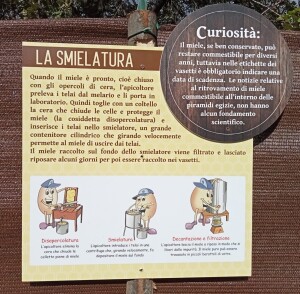 When the honey is ready, the beekeeper takes the frames and takes them to the laboratory. Then he removes with a knife the wax that closes the cells and protects the honey and inserts the frames in a large circular container which, turning quickly, allows the honey to come out of them. The honey collected at the bottom of the honey extractor is filtered and left to rest for a few days before being collected in jars. Honey, if well preserved, can remain edible for several years.
When the honey is ready, the beekeeper takes the frames and takes them to the laboratory. Then he removes with a knife the wax that closes the cells and protects the honey and inserts the frames in a large circular container which, turning quickly, allows the honey to come out of them. The honey collected at the bottom of the honey extractor is filtered and left to rest for a few days before being collected in jars. Honey, if well preserved, can remain edible for several years.
HONEY
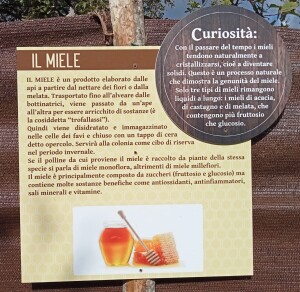 The honey transported to the beehive is passed from one bee to another to be enriched with substances. Then it is dehydrated and stored in honeycomb cells and closed with a wax cap. It will serve the colony as reserve food in the winter. If the pollen from which the honey comes is collected from plants of the same species, it is referred to as monoflora honey, otherwise it is multi-flower one. Honey is mainly composed of sugars (fructose and glucose) but contains many beneficial substances such as antioxidants, anti-inflammatories, mineral salts and vitamins. Over time honeys tend to become solid. This is a natural process which proves the genuineness of the honey. Only three types of honey remain liquid for a long time: those of acacia, chestnut and honeydew, which contain more fructose than glucose. To produce a kilo of honey, bees must visit at least two million flowers and travel a total distance of about 150,000 km.
The honey transported to the beehive is passed from one bee to another to be enriched with substances. Then it is dehydrated and stored in honeycomb cells and closed with a wax cap. It will serve the colony as reserve food in the winter. If the pollen from which the honey comes is collected from plants of the same species, it is referred to as monoflora honey, otherwise it is multi-flower one. Honey is mainly composed of sugars (fructose and glucose) but contains many beneficial substances such as antioxidants, anti-inflammatories, mineral salts and vitamins. Over time honeys tend to become solid. This is a natural process which proves the genuineness of the honey. Only three types of honey remain liquid for a long time: those of acacia, chestnut and honeydew, which contain more fructose than glucose. To produce a kilo of honey, bees must visit at least two million flowers and travel a total distance of about 150,000 km.
THE SICILIAN BLACK BEE
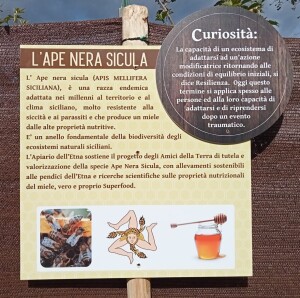 The Sicilian black bee (Sicilian Apis mellifera), is a breed adapted over the millennia to the Sicilian territory and climate, very resistant to drought and parasites, produces a honey with high nutritional properties. The Etna Apiary supports the “Amici della Terra” project for the protection and enhancement of the Sicilian Black Bee species, with sustainable farms on the slopes of Etna and scientific research on the nutritional properties of honey, a very real superfood.
The Sicilian black bee (Sicilian Apis mellifera), is a breed adapted over the millennia to the Sicilian territory and climate, very resistant to drought and parasites, produces a honey with high nutritional properties. The Etna Apiary supports the “Amici della Terra” project for the protection and enhancement of the Sicilian Black Bee species, with sustainable farms on the slopes of Etna and scientific research on the nutritional properties of honey, a very real superfood.
BEES AND ENVIRONMENT
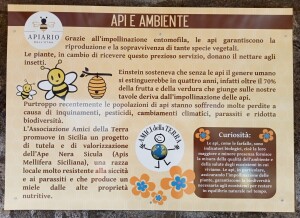 Thanks to pollination, bees guarantee the reproduction and survival of many plant species. The plants, in exchange for receiving this precious service, donate the nectar to the insects. Einstein claimed that without bees mankind would become extinct in four years, in fact over 70% of the fruit and vegetables that reach our tables derive from the pollination of bees. Bees, like butterflies, are biological indicators, their greater or lesser presence provides a measure of the quality of the environment and the health of the ecosystems in which we live.
Thanks to pollination, bees guarantee the reproduction and survival of many plant species. The plants, in exchange for receiving this precious service, donate the nectar to the insects. Einstein claimed that without bees mankind would become extinct in four years, in fact over 70% of the fruit and vegetables that reach our tables derive from the pollination of bees. Bees, like butterflies, are biological indicators, their greater or lesser presence provides a measure of the quality of the environment and the health of the ecosystems in which we live.
HONEY: FOOD OF THE GODS
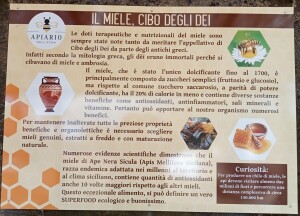 The therapeutic and nutritional qualities of honey have always been known so as to deserve the nickname of Food of the Gods by the ancient Greeks. In fact, according to Greek mythology, the gods were immortal because they ate honey and ambrosia. Honey, which was the only sweetener until the 1700s, is mainly composed of simple sugars (fructose and glucose), but compared to the common sucrose one, with the same sweetening power, it has 20% fewer calories and contains various beneficial substances such as antioxidants, anti-inflammatories, mineral salts and vitamins. Therefore it can bring many benefits to our body.
The therapeutic and nutritional qualities of honey have always been known so as to deserve the nickname of Food of the Gods by the ancient Greeks. In fact, according to Greek mythology, the gods were immortal because they ate honey and ambrosia. Honey, which was the only sweetener until the 1700s, is mainly composed of simple sugars (fructose and glucose), but compared to the common sucrose one, with the same sweetening power, it has 20% fewer calories and contains various beneficial substances such as antioxidants, anti-inflammatories, mineral salts and vitamins. Therefore it can bring many benefits to our body.


